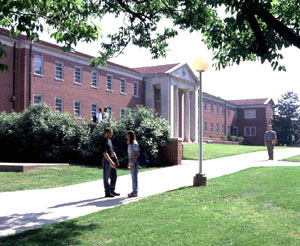
University of Tennessee at Martin
The only public four-year college in West Tennessee outside Memphis, the University of Tennessee at Martin traces its roots to Hall-Moody Institute, founded by local Baptists in 1900. Named for J. N. Hall and J. B. Moody, two prominent Baptist ministers, Hall-Moody offered elementary, high school, and college courses, plus training for Baptist ministerial students. By 1917-18 the state fully accredited all courses, and the school became known as Hall-Moody Junior College.
Hall-Moody enjoyed periodic growth but faced constant financial difficulties. In 1926-27, after a drive to raise $75,000 failed, the college consolidated with Union University, another Baptist institution, located in Jackson, Tennessee. On June 1, 1927, Hall-Moody officially closed.
With the demise of the college, local citizens petitioned the state to establish a new junior college under the administration of the University of Tennessee. In February 1927, the state legislature passed Senate Bill 301, which provided for a junior college offering agriculture, industrial arts, and home economics. Shortly afterwards, the City of Martin and Weakley County each voted to issue $100,000 in bonds to purchase the Hall-Moody plant, secure additional land, and add new facilities.
In September 1927 the University of Tennessee Junior College (UTJC) opened with an enrollment of 120 students, a faculty and staff of sixteen, and a budget of $75,000. C. Porter Claxton served as executive officer until 1934. Three new classroom buildings, a gymnasium, and a steam plant were built before the Great Depression took its toll. During the depression years, enrollment declined, construction ceased, and the budget fell drastically. The low point came in 1933, when the fall enrollment dropped to ninety-two, and intercollegiate athletics were suspended.
Fortunately for UTJC, a group of determined West Tennessee citizens petitioned the university and the legislature for an expansion of the junior college curriculum, and a new program, which included two years in liberal arts and education, was approved in 1934. Intercollegiate athletics also were reinstated. At the same time, Paul Meek became executive officer; during his tenure enrollment and facilities gradually increased.
Dark days returned with the outbreak of World War II, when enrollment again dropped to 115 students, with only twenty-four men. In 1942 UTJC obtained a program to train naval aviation cadets, which provided the school with sorely needed funds and held the faculty together.
After World War II, the veterans returned, and the fall quarter enrollment in 1946 surged to 649. The school quickly erected temporary buildings and added new faculty. National accolades came in 1946 when Look Magazine rated UTJC among the top fifteen junior colleges in the nation. In 1951 the state legislators and administrators recognized area needs and elevated the junior college to four-year status, renaming it the University of Tennessee Martin Branch. The school was authorized to award degrees in agriculture and home economics. All other areas remained limited to two years until 1957, when a degree program in education was approved. Four years later majors in business administration and liberal arts were added to the curriculum.
The physical plant burgeoned to meet the needs of an enrollment which doubled during the 1950s; even greater growth occurred in the 1960s with the entry of the “Baby Boomers.” By 1970 UT Martin’s enrollment had reached 4,622, placing the college among the fastest growing institutions in the state.
In 1967 the school’s name was changed to the University of Tennessee at Martin. Paul Meek retired after thirty-three years of service, and Archie Dykes was appointed chancellor. In 1971 Dykes was replaced by Larry T. McGehee, who remained until 1979. Charles E. Smith assumed the helm from 1979 to 1985, followed by Chancellor Margaret N. Perry.
After a leveling of the enrollment in the 1980s, UT Martin experienced a resurgence in the 1990s and achieved a record enrollment of 5,812 students in 1995. In 1996 a four-year engineering program was implemented.
UT Martin focuses primarily on undergraduate training, currently offering degree programs in over eighty specialized fields. UTM students report a high acceptance rate into graduate and professional schools, and its alumni are located in virtually every state in the nation and many foreign countries.
Today, UT Martin’s land, buildings, and equipment have an estimated value of over $143,000,000. This includes the 250-acre campus, a 680-acre experiment farm, forty-four academic and support buildings, six dormitories, and 256 apartments for married students. As UT Martin celebrated its one-hundredth birthday in 2000, the founders undoubtedly would have viewed with pride the growth of the school from a fledgling one-building institution to a bustling primary campus of the University of Tennessee system.
In 2001 Dr. Nick Dunagan became the university’s Chancellor. Enrollment stood at 5,800 students, who took courses in eighty specialized fields of undergraduate study and in the graduate fields of accounting and business administration; counseling and teaching education; family and consumer sciences; and agricultural operations management.
Suggested Reading
Robert L. Carroll, The University of Tennessee at Martin: The First One Hundred Years (2000); Neil Graves, A Picture History of Hall-Moody (1975)



